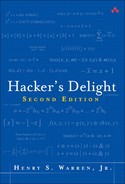Appendix A. Arithmetic Tables for A 4-Bit Machine
In the tables in Appendix A, underlining denotes signed overflow. For example, in Table A–1, 7 + 1 = 8, which is not representable as a signed integer on a 4-bit machine, so signed overflow occurred.

The table for subtraction (Table A–2) assumes that the carry bit for a − b is set as it would be for ![]() , so that carry is equivalent to “not borrow.”
, so that carry is equivalent to “not borrow.”
TABLE A–2. SUBTRACTION (ROW – COLUMN)

For multiplication (Tables A–3 and A–4), overflow means that the result cannot be expressed as a 4-bit quantity. For signed multiplication (Table A–3), this is equivalent to the first five bits of the 8-bit result not being all 1’s or all 0’s.
TABLE A–3. SIGNED MULTIPLICATION

TABLE A–4. UNSIGNED MULTIPLICATION

Tables A–5 and A–6 are for conventional truncating division. Table A–5 shows a result of 8 with overflow for the case of the maximum negative number divided by –1, but on most machines the result in this case is undefined, or the operation is suppressed.
TABLE A–5. SIGNED SHORT DIVISION (ROW ÷ COLUMN)

TABLE A–6. UNSIGNED SHORT DIVISION (ROW ÷ COLUMN)

Tables A–7 and A–8 give the remainder associated with conventional truncating division. Table A–7 shows a result of 0 for the case of the maximum negative number divided by –1, but on most machines the result for this case is undefined, or the operation is suppressed.
TABLE A–7. REMAINDER FOR SIGNED SHORT DIVISION (ROW ÷ COLUMN)

TABLE A–8. REMAINDER FOR UNSIGNED SHORT DIVISION (ROW ÷ COLUMN)

